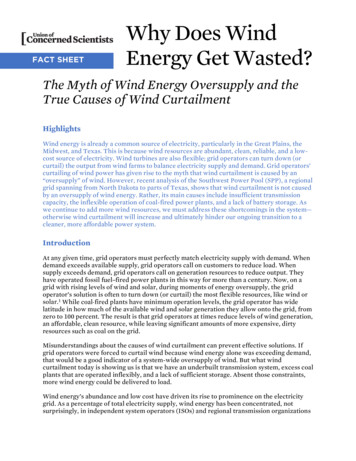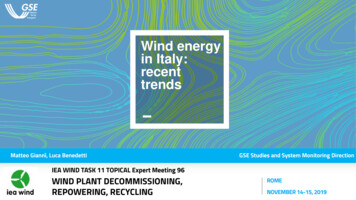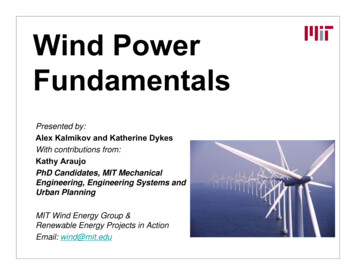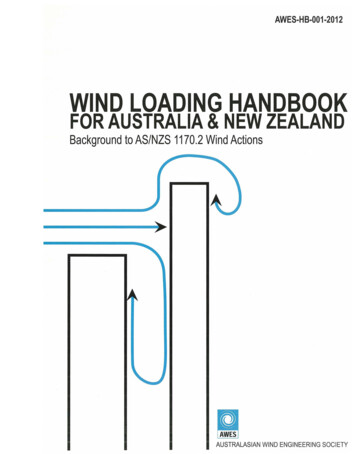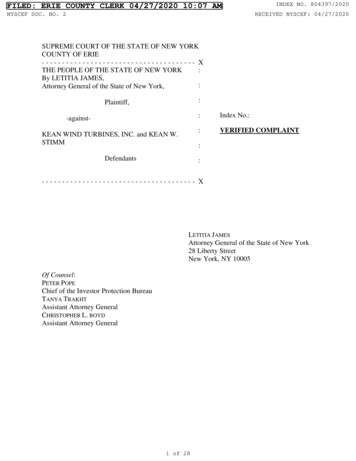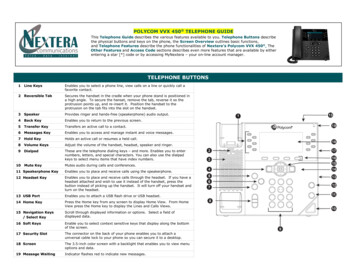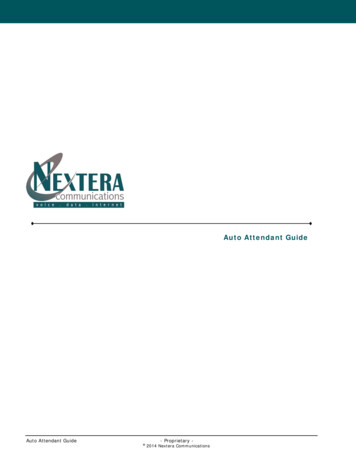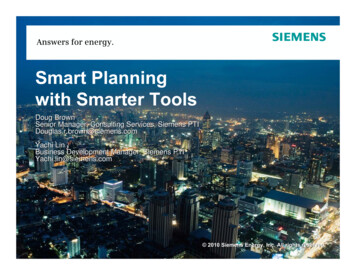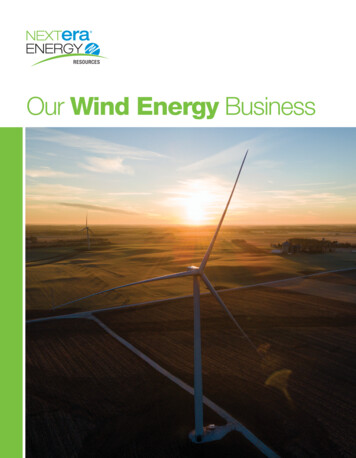
Transcription
Our Wind Energy Business
Wind Energy Helps Our NationA Diversified PortfolioTotal Net Megawatts: 19,060Updated: December 31, 2017* Includes megawatts associated with noncontrollinginterests related to NextEra Energy Partners, LPWind energy, produced at wind farms like the 109-megawatt (MW) Buffalo Ridge Wind Energy Center in Minnesota, provides a reliable, long-termincome for farmers and ranchers, and acts as a drought-resistant crop.Clean, reliable and affordable windenergyFor nations and communities to thrive, we must have anaffordable, reliable, clean supply of energy. NextEra EnergyResources, LLC, is helping to address this issue as the world'slargest generator of renewable energy from the wind and sun.We believe wind and other clean energy sources can helpreduce our use of fossil fuels while at the same timeempowering a new era of economic growth.Wind energy is clean, relying solely on the wind togenerate electricity.Wind energy provides diversified income to farmers andranchers, enabling them to continue using their land asthey always have to help feed the world. With wind energy,they’re also helping power North America with clean,renewable electricity.2Wind energy provides much-needed income to ruralcommunities, benefiting schools, libraries and other publicservices.Clean energy from the wind is homegrown. It doesn’t get muchmore homegrown than electricity generated in your owncommunity to benefit your own community.Leading the wind industryCommercial wind generation has existed in the U.S. for morethan 30 years. NextEra Energy Resources entered the windgeneration business in 1989 with the acquisition of severalexisting wind projects in Southern California. In 1998, thecompany built its first wind project in Oregon. The next 10years were marked by significant growth, including thedevelopment and acquisition of wind projects in Canada.Today, NextEra Energy Resources operates 136 wind projects.
Why wind?The benefits of NextEra Energy Resources’ focus on windare considerable. Wind energy:» Creates no greenhouse gases or other air pollutants.» Uses no water resources to generate electricity.» Allows landowners to use their land as before.» Provides a renewable fuel supply.» Creates no waste byproducts for disposal.» Results in no hazardous cleanup at the end of a project’sproductive life.RepoweringNextEra Energy Resources is working to upgrade theperformance of older turbine technology at select sites,adding longer blades and updated gear boxes to improvetheir operation and generate more electricity for customers.Skeleton Creek Wind inOklahoma is part of a new eraof renewable energy projects.Skeleton Creek generates upto 250 MW of wind energy.An additional phase of theproject will add up to 250 MWof solar energy and a 200MW battery energy storagesystem.Partnerships are Forged with LandownersHelping their communitiesNextEra Energy Resources' wind generation projects arebuilt on land owned by people who choose to partner withus. We don’t buy the land where our turbines sit; we enterinto lease agreements with landowners who volunteer toparticipate in a project.We want landowners to continue using their land as theyalways have – for farming, ranching, logging, mining, huntingand recreation – and we work closely with landowners inpositioning turbines on their property.Landowners who host wind turbines on their land aremaking a commitment to their families, their communitiesand the future. Our commitment is to be a caring co-stewardof the land with our hosts to help preserve and maintain it forfuture generations.Vital landowner relationshipsMost landowners at our wind projects are individuals orfamilies. Some are businesses or government agencies. Allare committed to preserving the quality and value of theirland and continuing to use the land as they always have.Each turbine and access road takes about an acre of landout of production.In an area we think would support a wind project, ourrelationship with landowners begins with a call or visit froma land services representative, who will introduce thelandowner to the company and the idea of a wind project.Often, landowners contact us, offering their land for awind project.If an area is promising after our initial assessment, NextEraEnergy Resources will enter into a land use option agreementwith landowners, which may provide additional time forfurther evaluation of the property for the possibility of winddevelopment. It can be several years from our firstconversation to the point that the company is ready to beginconstruction on a wind project. Before work begins,landowners sign a contract.Landowners receive easement payments for each windturbine on their land, but landowners are not the onlybeneficiaries. Their decision to host wind turbines bringsadditional jobs to the area, increased tax revenue, thecompany’s support of local community activities and ourpurchases of local goods and services.Easement payments are based on the number of windturbines on their land. The payments are established in acontract between the company and the landowner. Paymentsper turbine vary from site to site, based on the quality of thewind resource, proximity to existing transmission lines andcurrent market conditions in the area for electricity.NextEra Energy Resources pays all project-related taxesrequired by state and local governments. The amount of taxpayments depends upon taxation laws in the host state orcounty. The company pays any taxes assessed against thewind turbines on the landowner’s property.3
Developing a wind projectEnvironmental Stewardship» NextEra Energy Resources works closelywith federal, state and local environmentalorganizations.» Environmental assessments determinesuitability of prospective wind sites.» Land and wildlife are respected andprotected during constructionand operations.» Land is restored after construction.Siting a wind project is challenging work – finding the rightcombination of wind conditions, power transmission lines andland. While our land services representatives work withlandowners to familiarize them with the process and what toexpect, our developers are busy on a wide range of issuesrelated to developing a wind site. They will:» Meet with and provide information to local officials onproject progress.» Conduct environmental assessments.» Complete historical and archaeological reviews.» Arrange to connect to the local power grid.» Secure customers for the site’s electricity.» Attend public meetings to gain approval for building.» Obtain approval from the Federal Aviation Administration.» Procure equipment.Wind farms allow landowners to continue to use their land while diversifying their income.4
Crews are Experienced in ConstructionOur general contractors hire as many local workers as possible for projects like the Wheatridge Renewable Energy Center in Oregon.Construction is carefully plannedNextEra Energy Resources’ construction team has builtdozens of wind energy projects around the country, includingone of the world’s largest wind farms in Texas. When allapprovals are in place and landowners have signed theircontracts, construction can begin. Our construction managersand engineers oversee and are responsible for all work and allcontractors at a construction site. They, and often theirfamilies, live in the community during construction.Approximately 200 contractors can be involved in a typicalwind construction project. Our goal is to have our generalcontractor hire as many workers from the area as possible. Weare looking for heavy equipment operators, electricians,laborers, security and others.Construction typically takes between six and nine months.NextEra Energy Resources has a carefully designed plan forturbine placement, but works closely with landowners toensure the turbine location is compatible with other land uses.Our construction manager and staff stay in close contact notonly with landowners, but also local government. This keepsinterested parties apprised of progress and ensures adherenceto all local building code requirements.» The first step in construction is to put in high-quality gravelroads to accommodate our heavy equipment.» Underground electrical cabling is then laid beside theaccess roads.» Wind turbine foundations are dug and poured.» Work will begin on a substation, and an operations andmaintenance building.» Turbine equipment arrives.» Cranes begin erecting the turbines.» The completed turbines are tested and commissioned.» When construction is complete, the land is reclaimed anddeep tilled to return it to crop production or reseeded withnative grasses.We are committed to leaving the land in as good or bettercondition than we found it. When construction is completeand the plant has begun commercial operation, the site isturned over to our operations staff who will operate andmaintain the wind project.5
Wind Team Focuses on Operational ExcellenceAttention to safety and trainingIn 2008, NextEra Energy Resources’ Gray County Wind EnergyCenter in Montezuma, Kansas, became the first wind project in thenation to earn the Occupational Safety and Health Administration’stop safety award, the Voluntary Protection Program Star Status.Gray County was just the first. Our operations team is engaged inan ongoing project as part of its overall safety program to achieveStar Status for all of our wind projects.Right behind safety is training. NextEra Energy Resources’ windtechnician training includes online learning, classroom training andfield training. Our company also has working partnerships with twocolleges in Texas to provide on-site training for our technicians.Additionally, through courses taught at the colleges and supportedthrough our partnerships, the colleges serve as pipelines forfuture wind technicians. We also provide support to othertechnical colleges.How a wind turbine works1 A computer turns the nacelle (turbine outer housing) and therotor (which consists of three blades and a hub) to face intothe wind. The wind causes the turbine blades to turn agenerator to produce electricity. For safety purposes, theturbine shuts down automatically if the wind speed exceeds55 miles per hour.2 The electricity travels down the inside of the tower throughelectrical cables to a transformer at the base of the wind tower.3 From the transformer, the electricity flows through anunderground collection cable to an on-site substation.4 From the substation, overhead electrical cables take theelectricity to an off-site substation and into high-voltagetransmission lines.The NextEra Energy Resources Renewable OperationsControl Center in Juno Beach, Florida, provides remoteoperations support to NextEra Energy Resources’ wind,solar and energy storage sites.Each wind turbine in the fleet is controlled by a computer thatcan automatically turn the blades into the prevailing wind,adjust the angle of the blades to compensate for changingwind speeds, and shut a turbine down or restart it again. Thecomputer system can be remotely controlled by operatorsanywhere in the country.Our state-of-the-art operations control center is one of a fewin the U.S. wind industry and has a major role in remotelymanaging wind turbine operation. The Renewable OperationsControl Center maintains continuous oversight of windturbines at our sites. When our site personnel have gonehome for the evening, the control center staff is monitoringtheir wind turbines and can run diagnostic tests on turbinesor adjust operations as needed. The center collects data thatenables NextEra Energy Resources to schedule predictivemaintenance to help ensure efficient operation.5 The electricity goes from the high-voltage transmission linesinto local distribution lines.6 The electricity is then distributed to homes, schools,businesses and other consumers.6126534WinCe
NextEra Energy ResourcesGeneration Facilities in Operation(As of 12/31/20)Highlights of wind operations» 136 projects in 20 states and Canadawith more than 16,000 MW of windgeneration in operation.» Nearly 11,000 wind turbines.As of 12/31/20Wind Technician Dakota Beals at the 75-MW Steele Flats Wind EnergyCenter in Nebraska.7
NextEra Energy Resources, LLC700 Universe BoulevardJuno Beach, Florida POPOFPO
Wind energy, produced at wind farms like the 109-megawatt (MW) Buffalo Ridge Wind Energy Center in Minnesota, provides a reliable, long-term income for farmers and ranchers, and acts as a drought-resistant crop. Clean, reliable and affordable wind energy For nations and communities to thrive, we must have an

